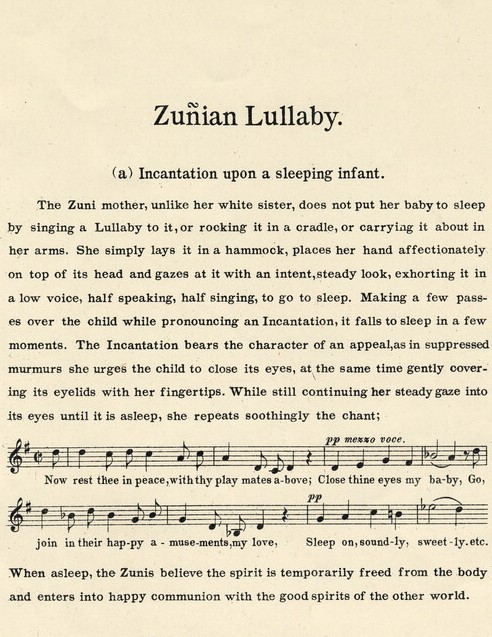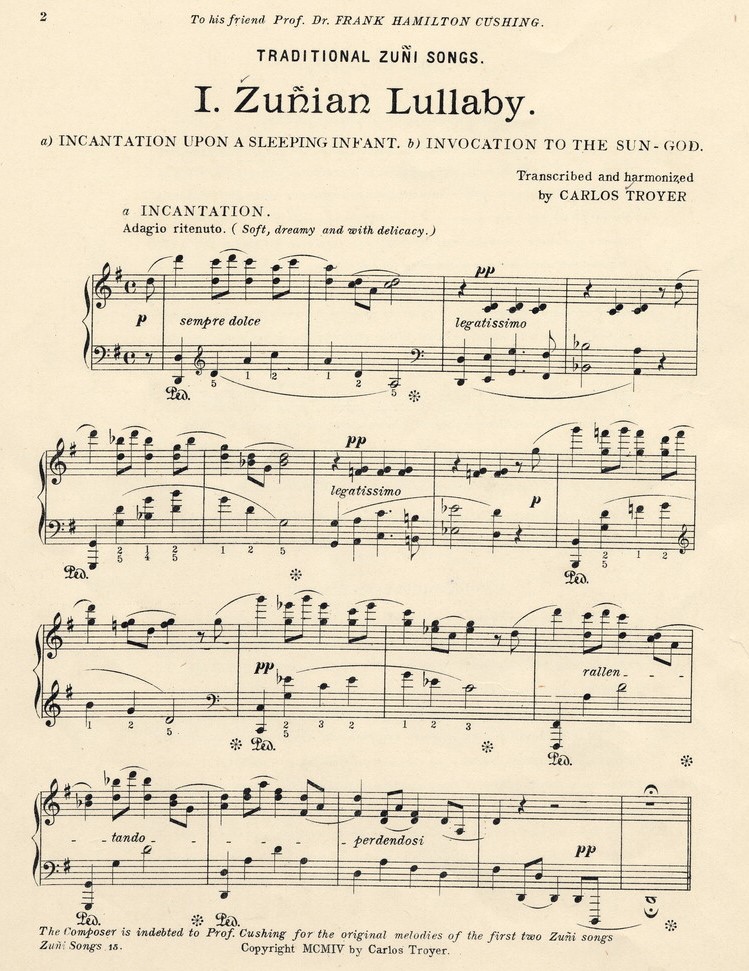Zunian Lullaby[1]
Transcribed and harmonized by Carlos Troyer
Annotations by JEssica Cory

The Zuni mother, unlike her white sister, does not put her baby to sleep by singing a Lullaby [sic] to it, or rocking it in a cradle, or carrying it about in her arms. She simply lays it in a hammock, places her hand affectionately on top of its head and gazes at it with an intent, steady look, exhorting it in a low voice, half speaking, half singing, to go to sleep. Making a few passes over the child while pronouncing an Incantation, it falls to sleep in a few moments. The Incantation bears the character of an appeal, as in suppressed murmurs she urges the child to close its eyes, at the same time gently covering its eyelids with her fingertips. While still continuing her steady gaze into its eyes until it is asleep, she repeats soothingly the chant;
“Now rest thee in peace, with thy playmates above; Close thine eyes my baby, Go join in their happy amusements, my love, Sleep on, soundly, sweetly, etc.”
When asleep, the Zunis believe the spirit is temporarily freed from the body and enters into happy communion with the good spirits of the other world.

Troyer, Carlos. “Zunian Lullaby.” Traditional Songs of the zunis. (Newton Center, MA: Wa-wan press, 1904), 4-5.
[1] In Troyer’s time, the tilde was commonly used when writing the word “Zuni.” However, it is not used anymore, hence its absence on this page.
Contexts
Troyer’s arrangement of “Zunian Lullaby” appears to only have been recorded by one artist, pianist Dario Müller. The song appears on Müller’s album The American Indianists, Vol. 2, which was released by Marco Polo Records in 1996.
Resources for Further Study
- It is important to recognize the limitations of Troyer’s work and experience. Because the recording above does not have lyrics, and the lyrics provided by Troyer are in English, a more accurate rendition of a Zuni lullaby may be this one, performed by Laughing Eyes (Margaret Eagle, or Margaret Lewis, per the Library of Congress).
- To learn more about the Zuni (a Pueblo people), their Nation’s website is good place to start.
- The original publication of Troyer’s view can be viewed digitally at the Library of Congress.
- Katy Strand designed this fantastic resource for the Smithsonian to teach about Zuni music (including lullabies), including several lessons, recordings, and assessments.
- The National Parks Service has some lesson plans that explore present-day Pueblo who live near the Bandelier National Monument area. Of course, it’s imperative to also consider the ways in which national parks and monuments have affected Native communities.